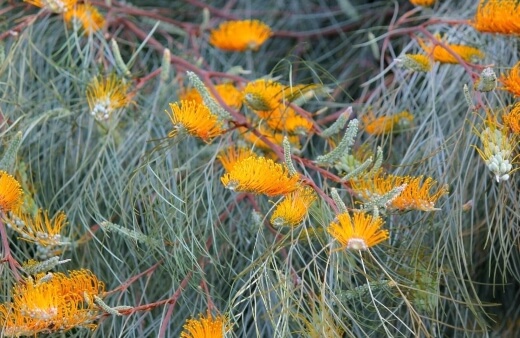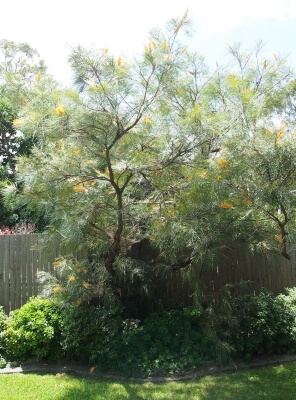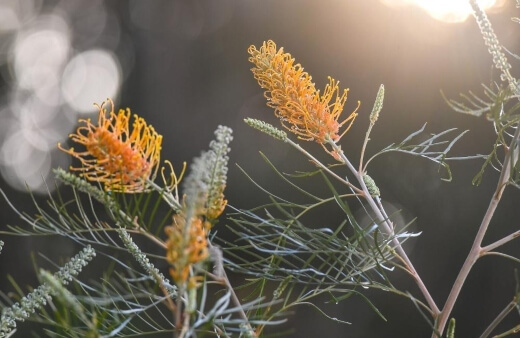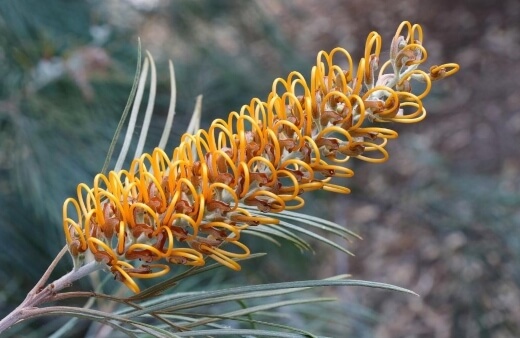Fast growing, tough and adaptable – that sounds like Grevillea ‘Honey Gem’, a plant I want in my garden! If it looks good, even better. Grevillea is a proudly Australian native plant and the Honey Gem cultivar is no exception.
The name probably gives it away – you’re expecting something sweet and lovely and that’s exactly what you’re going to get. Who says beauty can’t be tough too!
In our how to grow and care guide, we’ll take a look at how to propagate this shrub, the pests and diseases that can be an issue (usually caused by soil with bad drainage), how to care for and maintain the right conditions for the shrub, and end off with some frequently asked questions.
More...
Family: | Proteaceae |
|---|---|
Genus: | Grevillea |
Hybrid: | Grevillea banksii × Grevillea pteridifolia |
Cultivar: | ‘Honey Gem’ |
Common Names: | Grevillea ‘Honey Gem’ |
Location: | Outdoor |
Type: | Shrub |
Growth: | Up to 6 metres high by 5 metres wide |
Sun requirements: | Direct sunlight |
Foliage Colour: | Green grey |
Flower Colour: | Yellow, orange |
Flowering: | All year |
Fruit: | None |
Maintenance level: | Average |
Poisonous for pets: | Yes |
Introducing Grevillea ‘Honey Gem’

This cultivar of Grevillea comes from Queensland and has earned itself great popularity. The shrub can grow up to 6 metres high, and has fine leaves that have silver underneath.
The yellow orange flowers grow to about 16cm long, appearing in spring and then lasting pretty much most of the year. Grevilleas are part of the Proteaceae family and a much loved native plant.
With more than 350 species, you can imagine the variety and cultivars – these shrubs have flowers that are pink and red, purple and cream. The flowers of the Grevillea ‘Honey Gem’ in particular look like brushes or even spiders.
A bird bath or bird feeder is not the only way to attract beautiful visitors – the nectar of the Grevillea ‘Honey Gem’ will do the trick. You can expect visitors like honeyeaters, finches and wrens.
The most popular use of this shrub is to create hedges. They can handle drought and frost, making them fairly low maintenance.
How to Grow Grevillea ‘Honey Gem’

Source: plantpedia.com.au
What Soil to Use
This shrub needs well-draining soil otherwise you may end up with root rot. If you’re dealing with clay soil and are concerned about drainage, you can add gypsum.
Grevillea ‘Honey Gem’ likes a slightly acidic soil and it’s a good idea to add leaf matter and mulch too.
Sunlight Needs
Grevillea ‘Honey Gem’ needs to live in a spot where it’s going to get lots of direct sun. It doesn’t mind a little bit of shade but you need at least a few hours of direct sun each day.
Watering Grevillea ‘Honey Gem’
Until your shrub is established, you need to make sure it’s getting enough water. Ideally you want to plant in spring and then make sure it’s well watered during the summer.
Once your Grevillea ‘Honey Gem’ is more mature, you can then water occasionally.


Get Your Free Guide:
Master Growing Australian Natives eBook
A Must Have Complete Guide for Every Australian Garden
Get Your Free Guide:
Master Growing Australian Natives eBook
A Must Have Complete Guide for Every Australian Garden
Fertilising Tips
These shrubs thrive if you give them regular fertiliser. You need to be cautious in selecting the right one as Grevillea ‘Honey Gem’ is sensitive to phosphorus.
This means your regular fertiliser won’t do – you’ll need to opt for an organic choice with not more than 2% phosphorus.
Pruning Grevillea ‘Honey Gem’
You can prune your Grevillea ‘Honey Gem’ once a year. This results in more growth that gives the shrub an ever bushier look. Try and prune at the end of spring after flowering, or in autumn.
See our buying guide for a reliable pair of secateurs available today.
It’s important that the roots of the shrub aren’t disturbed in the process. You might notice as the Grevillea ‘Honey Gem’ ages that the middle to bottom of the shrub has fewer leaves.
A good strong pruning will encourage new growth on the old branches. Spring is when the shrub is growing the fastest which is why it’s a good time to prune, and don’t be afraid to be a bit ruthless when necessary.
Grevillea ‘Honey Gem’ Propagation

Propagation from Cuttings
Try and take your cuttings in summer or the beginning of autumn. Each cutting you’re going to use should be about 10cm long and you want to select shoots that are semi-ripe.
Fill your containers with coarse sand, dip the end of the cutting into a rooting hormone, and then plant. Give it some water but it’s really important that you don’t overwater them.
A good way to do this is to give the cuttings a regular mist spray. The cuttings should not be in the direct sun. It can take up to 6 months before any roots appear.
Growing Grevillea ‘Honey Gem’ from Seeds
You want to make sure you end up with viable seed to propagate. You can collect seed by popping a sock over the seed pod and when the pods ripen, the sock will catch them.
If you don’t want to do any treatment of the seed, you can just plant it straight away but it can then take up to 2 years before it will germinate. Over the seasons, the seed coat cracks open and then germination can begin.
If you intend to help the process along, you can soak the seeds before planting. This has been known to speed up germination. Warm water is fine and you can just pop them in a shallow bowl.
You want to soak the seeds long enough to swell and a recommendation is 8 to 12 hours of soaking time. If the water is very hot or boiling, it will need less time to soak.
Start off by preparing your seed starting soil mix and once you’ve planted the seeds, cover it with a plastic bag. Pop your tray or container somewhere warm and make sure that your potting mix doesn’t dry out. The germination process is anywhere from 1 to 8 weeks.
Looking for more advice on how to garden and grow grevilleas? Check out our complete gardener’s guide for establishing your very own much loved Australian native shrub.
Pests and Diseases that Affect Grevillea ‘Honey Gem’

Source: davesgarden.com
Cercospora Leaf Spot Fungal Infection
Cercospora leaf spot is a common one and loves humidity. The disease starts with the leaves and then moves to the branches. When it first begins, you might notice light brown spots which then become yellow or brown.
The leaves eventually drop off. You can use an organic fungal treatment which is better for the environment too.
Phyllosticta Leaf Spot Fungal Infection
Phyllosticta thrives in moist conditions with bad air flow. You’ll notice spots on the leaves that have a red or brown border. Sometimes the spots are small and sometimes they take up big portions of a leaf.
Leaves might start to turn yellow and there might be holes in parts of the leaves too. When you water your Grevillea ‘Honey Gem’, be sure to wet the soil and not the leaves.
You can try spraying the leaves with a mixture of baking soda and water.
Cinnamon Fungus
Cinnamon fungus is a disease that can end up killing your Grevillea ‘Honey Gem’. It attacks the root system of the shrub and this means it can’t access nutrients and water to stay alive.
This is why it’s so vital not to let your plant grow in waterlogged soil for a long time. Symptoms you’re looking out for are orange to red streaks under the bark and leaves that are wilting and have become yellow, red or purple.
If your soil has good drainage you shouldn’t need to worry about this fungus and to be on the safe side, don’t let water touch the leaves and trunk of the shrub.
Honey Fungus
Honey fungus is another type of root rot disease that happens when soil has bad drainage. The symptoms show up very slowly and sometimes you don’t even know the shrub is under attack because the disease starts with the roots.
It can take up to a few years before you notice anything happening above the soil. When you do start noticing symptoms it would be things like die back with wilted and yellow leaves.
Have a look under the bark – another telltale sign is a creamy white substance growing between the wood. Roots under attack have black threads on them.
Sometimes mushrooms that are honey-coloured start growing around the base of the shrub. The bad news is that there isn’t really a successful treatment for honey fungus and within 2 years your Grevillea ‘Honey Gem’ could be dead.
You can help to control the disease by airing the section of the shrub between the root and the stem while it’s growing.
Sooty mould
This fungus ends up on the shrub because aphids and mealybugs leave behind a sticky substance that turns into a grey black fungus on the leaves. It won’t kill the plant but the thick mould does have a knock on effect.
It limits the amount of sunlight exposure and this relates to healthy growth. There might even be leaves that drop off as a result. You can get rid of the mould by washing the leaves with water.
Scale
These insects actually have a waxy shell that protects them. They love the Grevillea ‘Honey Gem’ leaves and are quite destructive. The leaves become yellow and the scale causes die back in the stems too.
These insects look like bumps on the leaves and stems and are usually white or brown in colour. You can wipe the affected areas of the plant with insecticide soap or neem oil which also works wonders.
Caterpillars and other insects
Grevillea leaf miner larvae find the shrub absolutely delicious. Looper caterpillars are another one to look out for. If you want to put nature to work as a cure, you can use ladybirds or make a garden setting that attracts birds who will happily feed on the insects for you.
To help you with the latter, check out our list of bird bath ideas popular in Australia.
Grevillea ‘Honey Gem’ Frequently Asked Questions

Does Grevillea ‘Honey Gem’ have invasive roots?
This shrub actually has a shallow root system. It means you don’t have to worry about parts of your home like pipes and walls being damaged.
Is Grevillea ‘Honey Gem’ poisonous?
A few of the Grevillea species do cause an allergic reaction – this could be in the form of itching, or a rash on the skin. In severe cases, it might cause an asthma attack. The leaves in particular are the most poisonous.
How long can a Grevillea ‘Honey Gem’ live for?
This amazing shrub can live up to 65 years.
What species of Grevillea were combined to make the Grevillea ‘Honey Gem’ cultivar?
Grevillea ‘Honey Gem’ is a hybrid mix of Grevillea banksii and Grevillea pteridifolia and this is one of the most popular hybrids.
Where does the Grevillea ‘Honey Gem’ get its name from?
The name Grevillea is after Charles Francis Greville. He was an 18th century botany patron and he co-founded the Royal Horticultural Society. He was also a British politician in the House of Commons from 1774 to 1790. ‘Honey Gem’ is the name given because of the golden orange flowers of this shrub.
Can you eat the Grevillea ‘Honey Gem’?
The flowers of the grevillea were loved by the indigenous Australian community because of their sweet nectar. Sometimes the nectar was shaken out of the flower to enjoy as is, but was also mixed with water to make a drink. In fact, these flowers were considered the first bush lollies.
Add Colour to Your Garden with the Grevillea ‘Honey Gem’
The Grevillea ‘Honey Gem’ is a brilliant sight with its yellow orange flowers that look almost like an insect. This is offset perfectly against wispy green leaves.
This native Australian shrub certainly packs a punch – it’s good looking, attracts garden visitors of the best kind, and is easily propagated from cuttings or seed.
It’s not difficult to see why this is one of the most popular cultivars of Grevillea and we’re giving Grevillea ‘Honey Gem’ our green thumbs up!
Published on August 16, 2022 by Nathan Schwartz
Last Updated on September 19, 2025





Hello,
had a young honey gem grevillea tree growing in the south western end of my garden which had snapped off at ground level at the base of the trunk, a bit over a month ago from storm damage, with 2/3s through the base of the trunk severed off the tree (at ground level).
I was lucky to speak to a fantastic horticulturist working in Bunnings, who said there's every chance it would grow back again, even stronger and to it's natural height. On his advice I cut the tree off the remaining third of the partially severed trunk (at ground level) on a clean slight slope to allow rain run off. The stump and roots still look very strong and healthy..He advised me to paint it with a water based bitumen kind of stuff (thank god it's non toxic!).
Could you tell me how long do you think it might take to grow back to it's natural height?
Looking forward to your reply,
kind regards
Lani
Hi there Lani,
Firstly, it sounds like you were given some great advice and congrats on all the hard work you’ve put into restoring your honey gem thus far. These trees are very resilient so I have no doubt that your tree will be able to bounce back stronger than before, it will just take some time.
It’s unfortunately a little difficult to say exactly how long your tree will take to reach its full natural height again as growing rate can be influenced by many factors.
Generally, this cultivar is considered quite fast-growing, typically taking about 5 years to reach its optimum height of around 3 to 5 metres tall and 2 to 4 metres wide. I would say 3 to 5 years is a pretty fair benchmark for you to consider with your tree.
We wish you all the very best with your Grevillea and hope that it is unaffected by storm damage in the future.
Gary Clarke
Hello Gary,
Thanks so much for your previous advise re my storm damaged honey gem grevillia tree a few weeks ago.
Another problem I've got is 3 orange trees that were damaged by overwatering while waiting to be planted into the ground about 3 years ago:
Then on planting, erroneously feeding lots of mushroom compost.
Have amended the soil resulting in lovely green leaves, although needing to treat with pretty effective homemade white oil for leaf minor:
Recently, hairy caterpillars stripped a lot of their branches of leaves, killing some of the branches (erradicated them with homemade vinaeger diluted water):
one of the very stunted orange cara cara trees is only about 600 mm high.
Do you think there's any chance they'll reach the 3m hight or the privacy and health I'm longing for or should I replace them?
Many thanks once again,
Hello again Lani,
I hope things are going well with your honey gem.
It sounds like your orange trees have had a bit of a rough time thus far, I’m sorry to hear that. Well done on repairing many of the issues so far though, new leaf growth is always a good sign and at least you were able to get rid of the caterpillars recently.
It’s hard for me to guarantee that your trees will still be able to reach 3 metres but I always prefer to believe that with some TLC, you can repair a lot of damage and encourage healthy growth. I would start by trying to emulate the conditions of their natural environment as much as possible. So ideally, planted in the ground with full sun, moist soil with good drainage and shelter from wind.
When fertilising, aim to use a specific citrus fertiliser for optimal nutrient intake and some mulch can also help reduce the shock of rapidly changing temperatures. If you’re concerned about your soil quality, a top dressing of compost can go a long way. You mentioned you have some damaged branches. I would recommend pruning those away so your trees can prioritise new growth.
Generally, orange trees can take six to seven years to reach their mature height of about 3 metres so it is possible that with some time and attention, your trees could still reach your desired size.
Ultimately, it’s your choice whether you want to try to nurture your current trees or purchase new healthy trees. I just hope I’ve been able to provide some helpful advice should you aim for the former.
Wishing you the very best Lani!